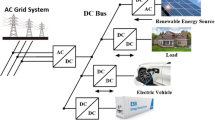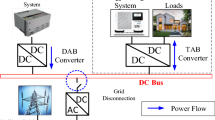Abstract
The bipolar hybrid microgrid is a newly emerged structure which has gained increasing attention during the last decades. The heart of this structure is the interlinking converter that plays a crucial role in this system and has three main functionalities: (1) bidirectional connection between AC and DC subsystems, (2) sinusoidal current injection with desired power factor to AC side and (3) providing two buses with equal voltages in DC side. This paper applies a recently proposed ten-switch inverter as an interlinking converter in the bipolar hybrid microgrid that can increase efficiency, reliability and power quality on AC and DC sides in such systems. Ten-switch converter has lower cost, volume and size compared to the conventional interlinking converters. A new modulation and control strategy is proposed for ten-switch converter in the bipolar hybrid microgrid which, unlike conventional systems, does not need any extra hardware as a voltage balancer converter to balance DC-link pole voltages. The effectiveness of the proposed modulation and control strategy of ten-switch converter is evaluated and compared with conventional structures in a simulation study. Adaptive power loss calculations and cost analysis are conducted and then compared with three interlinking converters candidates to show the superiority of the proposed interlinking converter.




























Similar content being viewed by others
References
Shahparasti M, Mohamadian M, Baboli PT, Yazdianp A (2017) Toward power quality management in hybrid AC–DC microgrid using LTC-L utility interactive inverter: load voltage-grid current tradeoff. IEEE Trans Smart Grid 8:857–867
Shamsi P, Fahimi B (2014) Stability assessment of a DC distribution network in a hybrid micro-grid application. IEEE Trans Smart Grid 5:2527–2534
Loh PC, Li D, Chai YK, Blaabjerg F (2013) Autonomous control of interlinking converter with energy storage in hybrid AC–DC microgrid. IEEE Trans Ind Appl 49:1374–1382
Mortezapour V, Lesani H (2017) Hybrid AC/DC microgrids: a generalized approach for autonomous droop-based primary control in islanded operations. Int J Electr Power Energy Syst 93:109–118
Kakigano H, Miura Y, Ise T (2010) Low-voltage bipolar-type dc microgrid for super high quality distribution. IEEE Trans Power Electron 25:3066–3075
Kaur A, Kaushal J, Basak P (2016) A review on microgrid central controller. Renew Sustain Energy Rev 55:338–345
Kabalcı E (2018) An islanded hybrid microgrid design with decentralized DC and AC subgrid controllers. Energy 153:185–199
Ziouani I, Boukhetala D, Darcherif AM et al (2018) Hierarchical control for flexible microgrid based on three-phase voltage source inverters operated in parallel. Int J Electr Power Energy Syst 95:188–201
Pavan Kumar YV, Bhimasingu R (2015) Renewable energy based microgrid system sizing and energy management for green buildings. J Mod Power Syst Clean Energy 3:1–13
Zhao H, Wu Q, Wang C et al (2015) Fuzzy logic based coordinated control of battery energy storage system and dispatchable distributed generation for microgrid. J Mod Power Syst Clean Energy 3:422–428
Li Y, Nejabatkhah F (2014) Overview of control, integration and energy management of microgrids. J Mod Power Syst Clean Energy 2:212–222
Sheshyekani K, Khajesalehi J, Hamzeh M, Dadjo Tavakoli S (2016) Decentralised voltage balancing in bipolar dc microgrids equipped with trans-z-source interlinking converter. IET Renew Power Gener 10:703–712
Busquets-Monge S, Bordonau J, Boroyevich D, Somavilla S (2004) The nearest three virtual space vector PWM—a modulation for the comprehensive neutral-point balancing in the three-level NPC inverter. IEEE Power Electron Lett 2:11–15
Rodriguez J, Bernet S, Steimer PK, Lizama IE (2010) A survey on neutral-point-clamped inverters. IEEE Trans Ind Electron 57:2219–2230
Mihalache L (2006) A hybrid 2/3 level converter with minimum switch count. In: Conference record—IAS annual meeting (IEEE industry applications society, vol. 2, pp. 611–618
Wang F (2002) Sine-triangle versus space-vector modulation for three-level PWM voltage-source inverters. IEEE Trans Ind Appl 38:500–506
Lu X, Guerrero JM, Sun K et al (2014) Hierarchical control of parallel AC–DC converter interfaces for hybrid microgrids. IEEE Trans Smart Grid 5:683–692
Kim JY, Jeon JH, Kim SK et al (2010) Cooperative control strategy of energy storage system and microsources for stabilizing the microgrid during islanded operation. IEEE Trans Power Electron 25:3037–3048
Rocabert J, Luna A, Blaabjerg F, Rodríguez P (2012) Control of power converters in AC microgrids. IEEE Trans Power Electron 27:4734–4749
Rocabert J, Azevedo GMS, Luna A et al (2011) Intelligent connection agent for three-phase grid-connected microgrids. IEEE Trans Power Electron 26:2993–3005
Kolar JWW, Zach FC, Casanellas F et al (1995) Losses in PWM inverters using IGBTs. IEE Proc - Electr Power Appl 142:285–288
Zhou Z, Khanniche MS, Igic P et al (2006) A fast power loss calculation method for long real time thermal simulation of IGBT modules for a three-phase inverter system. Int J Numer Model Electron Netw Devices Fields 19:33–46
Author information
Authors and Affiliations
Corresponding author
Additional information
Publisher's Note
Springer Nature remains neutral with regard to jurisdictional claims in published maps and institutional affiliations.
Rights and permissions
About this article
Cite this article
Najafi, P., Houshmand Viki, A. & Shahparasti, M. An integrated interlinking converter with DC-link voltage balancing capability for bipolar hybrid microgrid. Electr Eng 101, 895–909 (2019). https://doi.org/10.1007/s00202-019-00829-2
Received:
Accepted:
Published:
Issue Date:
DOI: https://doi.org/10.1007/s00202-019-00829-2




